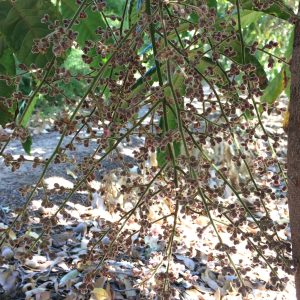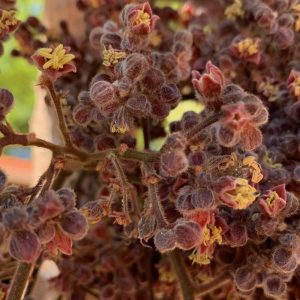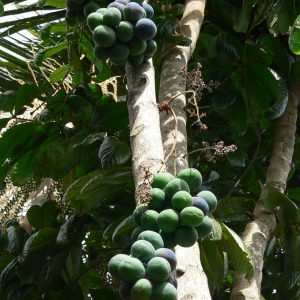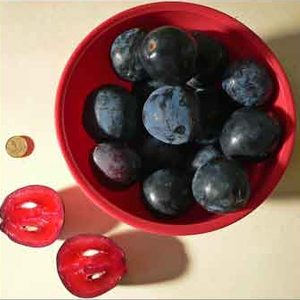Davidsonia spp.
Davidson’s plum
Origin
Plants are native to coastal areas in Queensland and northern NSW and are cultivated commercially on a minor scale in these regions as an emerging Australian bush food industry. There are only three species in the genus, Davidsonia pruriens (PR), D. jerseyana (JE) and D. johnsonii (JO), the last being the most rare and endangered of the three and not discussed below.
Climate
The indigenous areas are warm temperate and sub-tropical rainforests – mainly NE Qld up to elevations of 1000m for PR, and NE NSW lowlands for JE. They both require consistent rainfall throughout the year. Mature trees can withstand light frosts but younger plants will suffer damage.
Plant Description
PR is a slender upright tree to 15m high, while JE is more of a bush, 6-8m high with several branching slender stems. They have dense crowns of compound leaves, and tree parts of both are covered with long irritant bristly hairs. Seedling leaves are simple when young and alternately imparipinnate when adult with a scarcely (PR) and prominent (JE) winged rachis, dentate margins, and 8-15 oblong-obovate pinnae with the upper surface glossy green and lower dull, the terminal ones being largest. Adult leaves are 50-100 and 30-70cm long in PR and JE respectively. Both species are diploid.
Relatives
They are members of the Cunoniaceae family which has no other commonly known edible fruits. JE and JO have previously been regarded as varieties of PR but the latest taxonomic and genetic evidence indicates they are additional and separate species.
Soils
Not particular regarding soil type as long as organic matter is kept high. This not only retains and supplies nutrients but also helps maintain good moisture levels throughout the year.
Propagation
PR and JE are mainly grown from fresh seed; germination is cryptocotylar. Pyrenes with no seed have an empty flat shape and can be discarded. Viable ones are washed and some of the surrounding fibrous material removed. They are then sown in a simple non-soil potting mix; the later this is done or if seeds are allowed to dry out, the lower the percentage germination success which ideally can approach 70% in PR and 100% in JE within a few weeks.
Cultivars
There are no named cultivars as there has been no breeding work and the two species are basically still in the wild state. However two broad fruit types are found in PR differing in the relative amount of fruit skin hairs – so-called smooth and hairy.
Flowering and Pollination
Inflorescences are pendent panicles. In PR they are cauliflorous or ramiflorous and open, 10-80cm long with 2-20, 2-20cm long lateral spikes, while in JE they are mostly cauliflorous, more condensed, and only 4-10cm long. Hermaphrodite flowers for both species are apetalous, dark pink and 4-5 merous with hairy sepals 4-7mm long. They have 8-10 yellow stamens 4-7mm long, an ovary with 2 carpels each containing 5-7 ovules, and usually two curved styles. Flowering occurs mainly from February to July for PR and October to January for JE in their native areas. Flowers open usually in the afternoon at a rate of 1-2/d with generally no more than 10 being open at a given time on an inflorescence that may have more than 100 flower buds. PR is a facultative apomict; only about 10% of progeny is the result of sexual reproduction, but this provides an opportunity for the species to respond genetically to environmental challenges and prevent inbreeding depression. The major pathway is by pollination-dependent adventitious embryony, with these off-spring being clones of the parent. Polyembryony is common, and seeding survival is greater than for those from monoembryonic seeds. Reproduction in JE seems to be exclusively sexual, predominantly by selfing with no self-incompatibility within a plant or with others that are clones. Pollen for both species is very small and light, and wind is the most likely vector as relatively few fauna visit the flower, let alone being effective pollinators.
Cultivation
PR is more tolerant of full sunlight than JE but both will still grow in partial shade. Mulching is beneficial and although prolonged waterlogging is not tolerated, low moisture levels should be avoided, particularly during flowering and fruit set.
Regular applications of small amounts of fertiliser over the entire growing season will support high flower and fruit production.
Wind Tolerance
In windy sites either windbreaks will be necessary or they should be planted amongst shelter trees.
Pruning
Because inflorescences are cauliflorous or ramiflorous, fruit yield is increased by pruning apical shoots to encourage growth of multiple stems; this will also constrain height. Apical dominance will need to be addressed.
The Fruit
Fruits are obovoid (PR) or pyriform-obovoid (JE) drupes, 30-70g, 40-50mm long and 30-50mm wide. They have bluish black skin, dark red flesh, and usually two laterally compressed single-seeded pyrenes, 1.5-2.3cm long; 80% of fruit have only one viable seed which may be polyembryonic. Soft fibres, 1-2mm long, radiate outwards from the pyrenes into the flesh which is tart and not sweet (3% malic acid, Brix 4-6%). Fruit have reasonable polyphenol antioxidant levels, mainly as anthocyanins.
Fruit Production and Harvesting
In ideal conditions, the juvenility period for JE can be as short as 1-2 years, PR a little longer. In native areas fruit mature normally within 3-4 months from fruit set. Yield gradually increases with maturity, from 2-3kg/tree at 5-6 years up to 30kg in the most productive trees by 12-16 years. Care should be taken with the irritant hairs when harvesting. Fallen fruit is mature and can be collected from the ground and kept indoors until softening slightly.
Fruit Uses
The fruit has a very attractive plum-like shape and colour when mature, but even when fully ripe is much too sour for almost everybody. The flesh also doesn’t separate easily from the fibres that radiate out from the pyrenes. It is consequently a fruit that is normally processed into various products such as jams, juices and sauces, and also (like lemons) finds use as a flavouring agent to provide zing in cooked dishes.
Pests and Diseases
They are resistant to root pathogens. Caterpillars, beetles and Qld fruit fly will damage fruit and parrots will eat both ripe and semi-ripe fruit. PR usually ripens in the autumn and winter when pest load is reduced.
Comments
This is an attractive plant that can add an exotic, fern-like presence to a garden. Fruit yield can be plentiful given good conditions and management, but the most desirable form of processing for your palate will have to be established. Year round constant moisture levels will need to be maintained, and the ubiquitous hairs that are irritant to many people will need to be considered. It could be grown in a pot for several years, especially with JE.





